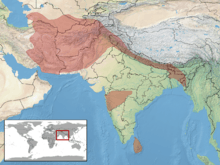Boiga trigonata
| Boiga trigonata | |
|---|---|
.jpg) | |
| Scientific classification | |
| Kingdom: | Animalia |
| Phylum: | Chordata |
| Subphylum: | Vertebrata |
| Class: | Reptilia |
| Order: | Squamata |
| Suborder: | Serpentes |
| Family: | Colubridae |
| Subfamily: | Colubrinae |
| Genus: | Boiga |
| Species: | B. trigonata |
| Binomial name | |
| Boiga trigonata (Schneider, 1802) | |
 | |
| Synonyms | |
Boiga trigonata, commonly known as the Indian gamma snake or common cat snake, is a species of rear-fanged colubrid endemic to South Asia.
Description
- See snake scales for terms used
B. trigonata has anterior palatine and mandibular teeth scarcely larger than the posterior. Its eyes are as long as the distance from its nostril; the rostral is broader than deep with the internasal scales shorter than the prefrontal scales. The frontal scales are longer than their distance from the end of the snout and shorter than the parietal scales. The loreals are as long as they are deep, or, they can be deeper than they are long. B. trigonata's one preocular does not extend to the upper surface of the head. The species has two postoculars, temporals 2+3, and 8 upper labials, with the third, fourth, and fifth entering the eye. They can have 4 or 5 lower labials in contact with the anterior chin-shields, which are about as long as the posterior. B. trigonata's body is moderately laterally compressed with smooth dorsal scales in 21 (or rarely 19) rows, with apical pits, disposed obliquely, with the vertebrals very feebly enlarged. There are 229-269 ventral scales, 79-92 divided subcaudal scales, and a single anal scale.
B. trigonata has a yellowish-olive or pale grey colour along the back and a white black-edged zigzag band along the length of the head with two brown bands edged with black, diverging posteriorly. The belly is white and can have a series of small brown spots along each side.
The total length is around 3 feet (91 cm) with a 7 inch (18 cm) tail.[3]
Geographic range
B. trigonata is found in the Perso-Baluchistan frontier.
It is distributed throughout Sri Lanka, India, Pakistan, Nepal, Bangladesh, Afghanistan (Leviton 1959: 461), southern Turkmenistan, southern Uzbekistan, southeastern Tajikistan, and Iran.
The race melanocephala is found in Pakistan; this form is variously considered as a subspecies, color variant, or full species.
Mimicry
Boiga trigonata strongly resembles venomous Echis carinatus in coloration and shape. Also, in India, these two species have almost identical geographic ranges.[3]
References
- ↑ Boulenger, G.A. 1896. Catalogue of the Snakes in the British Museum (Natural History). Volume III., Containing the Colubridæ (Opisthoglyphæ and Proteroglyphæ),... Trustees of the British Museum (Natural History). (Taylor and Francis, Printers.) LOndon. xiv + 727 pp. + Plates I.- XXV. (Dipsadomorphus trigonatus, pp. 62-63.)
- ↑ The Reptile Database. www.reptile-database.org.
- 1 2 Boulenger, G.A. 1890. The Fauna of British India, Including Ceylon and Burma. Reptilia and Batrachia. Secretary of State for India in Council. (Taylor and Francis, Printers.) London. xviii + 541 pp. (Dipsas trigonata, p. 358.)
Further reading
- Annandale, N. 1904. Additions to the Collection of Oriental Snakes in the Indian Museum. J. Asiat. Soc. Bengal 73: 207-211.
- Gans, C., and M. Latifi. 1973. Another Case of Presumptive Mimicry in Snakes. Copeia 1973 (4): 801-802.
- Leviton, A.E. 1959. Systematics and Zoogeography of Philippine Snakes. Unpublished Ph.D. thesis.
- Schneider, J.G. in Bechstein, J. M. 1802. Herrn de Lacépède's Naturgeschichte der Amphibien oder der eyerlegenden vierfüssigen Thiere und der Schlangen. Eine Fortsetzung von Buffon's Naturgeschichte aus dem Französischen übersetzt und mit Anmerkungen und Zusätzen versehen. Vierter Band [Volume 4]. Industrie Comptoir. Weimar. xx + 298 pp. + 48 plates. (Coluber trigonatus, pp. 256–257 + Plate 40, Figure 1.)